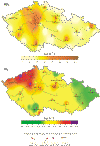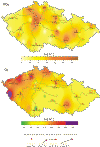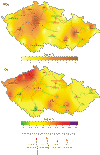|
|
AIR POLLUTION IN THE CZECH REPUBLIC IN 2001 Czech Hydrometeorological Institute - Air Quality Protection Division |
|
|
|
|
2.4 BRIEF EVALUATION OF METEOROLOGICAL CONDITIONS IN 2001
The year 2001, in spite of the fact that its average annual temperature was by 0.4 °C higher than the long-term normal, was markedly colder in comparison with the year 2000. The average annual temperature in 2001 was 7.9 °C, i.e. by 1.3 °C lower than the average annual temperature of the year 2000. The highest deviation of the average monthly temperatures from the normal +3.3 °C was recorded in October. The coldest month of the year 2001 was December with the deviation –2.6 °C. The 2001 precipitation was markedly above the long-term normal amounting to 676 mm. The annual total reached 811 mm, which is 120 % of the normal. The highest precipitation was recorded in September – 205 % of the month normal (108 mm), and on the contrary, the lowest amount was measured in the following month, October. Its 26 mm represent only 60 of the month normal. In winter periods of 2001 (January–March and October–December) the air pollution situation was favourable, while in the summer period there were several occurrences of increased concentrations of ground-level ozone during the days with higher air temperatures. Similarly as in 2000, it was necessary to issue several warning signals within the Smog Regulation System (SRS), and namely at the beginning of the year in January in the Ostrava smog area and in February in Prague. At the end of the year 2001, in November, two warning signals were issued in Prague. In the Ostrava smog area this signal was issued for 4 days and in Prague this measure was applied twice for two days. Totally the warning signal in the territory of the Czech Republic was issued for 8 days, which was by two days more than in 2000. Both in the Ostrava smog area and in Prague the signal was cancelled after the decline of the pollutants’ concentrations (mostly nitrogen oxides) after the change of meteorological situation and marked improvement of dispersion conditions in these regions. In the remaining smog areas of the Czech Republic the concentrations of the pollutants, mainly from combustion processes (sulphur dioxide, nitrogen oxides and SPM), did not reach the level of alert thresholds and therefore it was not necessary to activate the SRS in these areas. Meteorological conditions in the summer period of 2001 were not favourable for the occurrence of summer photochemical smog episodes. Maximum daily temperatures, measured from 1. 6. 2001 to 15. 9. 2001, were in average by 1.0 °C lower than the long-term mean. Nevertheless, during the monitored period there were 18 days with maximum temperatures above 27.0 °C, i. e. they were by 5.0 to 9.2 °C higher than the long-term average. Seven several-day episodes were recorded with maximum temperatures above 27 °C; but only four times the alert threshold for ozone 180 ÎĽg.m-3 was exceeded (Fig. 2.4.1). The more detailed analysis was carried out only for three one-day episodes in June, July and half-August. On 27. 8. 2001 the alert threshold for ozone was exceeded only at two stations and the concentration above 170 ÎĽg.m-3 was recorded only at one more station. During the first episode the large anticyclone extending from Greenland to the central Europe gradually spread to the African coast and on 26 and 27 June 2001 influenced the weather in the Czech Republic. During 28 June the flow of cold air entered Bohemia behind the cold front spreading from western Europe to northeast. On 26 and 27 June 2001 the weather was almost clear, only close to the mountains there occurred mild showers up to 0.4 mm. On the following day, 28 June, the weather was cloudy to overcast (the whole day in Bohemia and in the afternoon in Moravia) with showers and local storms. Maximum temperatures in the first two days amounted to 22–27 °C, after the passage of the cold front the temperature decreased from the west to 18 °C, only in southeast Moravia they reached 25 °C. The differences in the precipitation measured on 28 June were very high. The largest amount was recorded in ÄŚeskomoravská Highland and in the JesenĂky Mts. According to aerological observation carried out by CHMI in the morning on 27 June the wind in 800 m above the sea level was fresh, southwest, later in the morning it weakened and turned southeast, and up to east in early evening. The highest NO2 concentrations of 27 June were recorded mainly in the morning hours. In Prague, at NámÄ›stĂ Republiky station, they reached 117 ÎĽg.m-3, in a number of towns the concentrations ranged between 50 and 80 ÎĽg.m-3, the remaining territory recorded 10–25 ÎĽg.m-3. The warning alert threshold for ozone 180 ÎĽg.m-3 was exceeded at the stations Kladno, Všechlapy and SněžnĂk; the highest hourly concentration 192 ÎĽg.m-3 was measured in Rudolice v Horách. Increased concentrations above 170 ÎĽg.m-3 were measured in Litoměřice, Tušimice and Most (Fig. 2.4.2). The development of the meteorological situation from 30 July to 1 August was as follows: The anticyclone 1030 hPa with the center above the Azores spread by a ridge of higher pressure above western Europe and an independent anticyclone was formed moving northeast. On its rear side the warm air from the south began to enter central Europe on 31 July. In the evening and during the next day, 1 August, a ridge of higher pressure from the west was restored and along its front side the cold air from the northwest entered the territory of Czech Republic. On 30 and 31 July the weather was almost clear, later somewhat cloudy with local showers or storms. The last day of the episode (1 August) was somewhat cloudy to cloudy with showers; the precipitation did not exceed 3 mm. Maximum afternoon temperatures of the first day reached 25–30 °C, of the second day 28–33 °C. Behind the cold front the temperatures decreased to 21–26 °C, in southeast Moravia to 24–28 °C. The total length of sunshine on the first two days was 10–14 hours, on the last day in Bohemia 6–12 hours, in Moravia 3–9 hours. The distribution of NO2 concentrations on 31 July 2001 was similar as on 27 June 2001, with the exception of the lower levels in Prague. The levels higher than 180 ÎĽg.m-3 were measured in Litoměřice, Tušimice and Rudolice, and the level 198 ÎĽg.m-3 was recorded at PĹ™imda. The concentration above 170 ÎĽg.m-3 occurred at the station PĹ™ebuz (Fig. 2.4.3). Between 15 and 17 August 2001 the anticyclone of 1020 hPa with the centre above the Carpathian Mts. grew stronger to 1025 hPa during its passage to the Ukraine. On the first two days warm air entered the territory of the Czech Republic in its rear side, the third day the cold front moved over Bohemia towards the east followed by colder and unstable air mass. On 15 August the weather was predominantly clear with maximum temperatures 28–32 °C. On 16 August the weather was almost clear, only in the evening hours in western Bohemia it was cloudy with storms. Maximum temperatures amounted to 28–33 °C. On 17 August the weather in Bohemia was cloudy to overcast with showers and storms, and in Moravia somewhat cloudy. The afternoon temperatures reached 23–27 °C in Bohemia, in Moravia 27–31 °C. The distribution of NO2 concentrations on 16 August 2001 was very similar as on 31 July 2001. The ozone concentration 182 ÎĽg.m-3 was measured at station SněžnĂk and 193 ÎĽg.m-3 in Všechlapy. Stations Litoměřice, Teplice, ĂšstĂ nad Lab.-mÄ›sto and ĂšstĂ nad Labem-KoÄŤkov recorded more than 170 ÎĽg.m-3 (Fig. 2.4.4). It can be expected that ozone increases with regard to the regional level recorded in the northwest Bohemia, result from the emission of the precursors from the Prague agglomeration. The described meteorological conditions are favourable for the formation of the so called urban plume. In the previous years the existence of such plume was confirmed by airborne measurements of ozone and its precursors on the leeward side of Prague. Fig. 2.4.1 Course of maximum daily temperatures, their long-term average and occurrence of ozone concentrations exceeding 180 ÎĽg.m-3, Prague-Libuš 1.6.2001-15.9.2001 Fig. 2.4.2 Spatial distribution of maximum hourly concentrations of NO2 and O3, 27.6.2001 Fig. 2.4.3 Spatial distribution of maximum hourly concentrations of NO2 and O3, 31.7.2001 Fig. 2.4.4 Spatial distribution of maximum hourly concentrations of NO2 and O3, 16.8.2001
|



